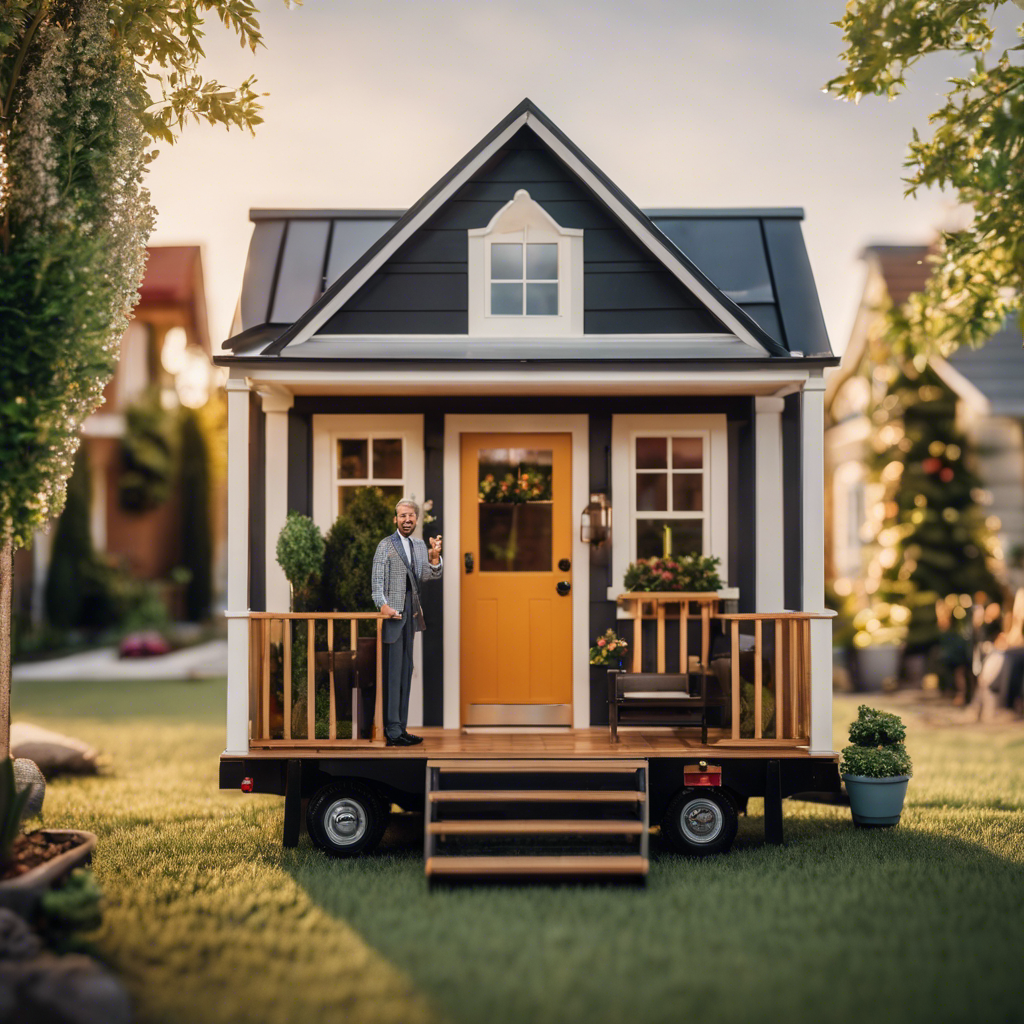As a devoted advocate of the tiny house movement, I’ve always been captivated by the allure of living simply and sustainably. But navigating the legal landscape can be a daunting challenge.
In this article, we’ll delve into the complexities of passing inspections and facing the obstacles that tiny house enthusiasts encounter. From misconceptions to zoning regulations, we’ll uncover the truth behind the legality of these compact dwellings.
Get ready to master the intricacies and discover the keys to unlocking the tiny house dream.
Common Misconceptions About Tiny House Legality

I’ve noticed that one common misconception about tiny house legality is that passing inspection automatically means the house is legally compliant. However, this isn’t always the case. While passing inspection is an important step in ensuring safety and adherence to building codes, it doesn’t guarantee that the tiny house is legally approved.
There are various challenges and complexities when it comes to the legality of tiny houses. Misunderstandings about building codes, lack of enforcement, and differing regulations in different jurisdictions contribute to the confusion.
It’s important to understand that the perception of legality can be misleading, as enforcement varies based on individual circumstances. Therefore, it’s crucial to thoroughly research and consult with local authorities to ensure compliance with zoning regulations and other legal requirements.
Factors Influencing Inspection Approval for Tiny Houses

Interestingly, factors that can influence inspection approval for tiny houses include the inspectors’ experience and the level of compliance demonstrated by the homeowners. When it comes to factors influencing inspection approval, building code enforcement plays a significant role.
Here are some key points to consider:
-
Factors influencing inspection approval:
-
Inspectors’ experience and knowledge of building codes
-
Homeowners’ level of compliance with building codes
-
Building code enforcement:
-
Ensuring compliance with safety regulations
-
Preventing shortcuts and ensuring quality in construction
These factors are essential in determining whether a tiny house will pass inspection. Inspectors rely on their experience and understanding of building codes to assess the compliance of the home. Homeowners who demonstrate a high level of compliance with these codes are more likely to receive approval.
It’s crucial for both parties to prioritize building code enforcement to ensure the safety and quality of tiny houses.
The Role of Inspectors in Enforcing Building Codes for Tiny Houses

The role of inspectors in enforcing building codes for tiny houses is vital for ensuring safety and compliance. However, there are challenges that can arise due to inspector bias and lack of resources.
Inspector bias can occur when inspectors are influenced by their personal preferences or motivations, leading to inconsistent enforcement of codes. This can be problematic as it undermines the purpose of building codes, which is to create uniform standards for safety and compliance. It also creates an unfair playing field for those who are trying to adhere to the codes but may face stricter scrutiny due to the inspector’s bias.
Additionally, inspectors may be overworked and lack the necessary resources to thoroughly inspect and enforce building codes for tiny houses. This can result in inspections that are rushed or not conducted at all, compromising the safety and compliance of these structures. Inadequate inspections can lead to potential hazards and structural issues that may endanger the occupants of the tiny houses.
To address these issues, it’s important for jurisdictions to provide inspectors with the support and resources they need to effectively enforce building codes for tiny houses. This includes proper training and education to minimize bias and ensure consistent enforcement. It also involves allocating sufficient staffing and funding to enable thorough inspections and timely follow-up on any violations or non-compliance.
Understanding the Difference Between Passing Inspection and Legal Compliance

Passing inspection is a significant step towards legal compliance with building codes. It’s crucial to understand the difference between passing inspection and being legally compliant. Here are some important points to consider:
Legal Implications:
- Simply passing inspection doesn’t guarantee legal compliance.
- Inspectors may choose not to pursue legal action against non-compliant tiny houses.
- The lack of pursuit or condemnation doesn’t make a tiny house legally approved.
- Enforcement of building codes varies based on individual circumstances.
Regulatory Compliance:
- Compliance with building codes is necessary to ensure the safety and quality of tiny houses.
- Zoning regulations play a crucial role in determining the legality of tiny homes.
- It’s important to check with the local planning and zoning office before considering a tiny home in a residential zoning district.
- Understanding and adhering to zoning laws and regulations is essential for regulatory compliance.
It is essential to navigate the complexities of legal implications and regulatory compliance to ensure that your tiny house is in full compliance with the law.
Navigating Zoning Regulations for Tiny Homes

As I navigate the zoning regulations for my tiny home, I must carefully consider the local planning and zoning office’s requirements. Understanding the legal restrictions surrounding tiny house zoning is crucial to ensure compliance and avoid any future issues. Each town has its own set of regulations, which may include specific foundation requirements or security measures.
It’s important to check with the local planning and zoning office before considering a tiny home in a residential zoning district. Additionally, zoning laws vary for rural areas, and specific requirements, such as pillar foundations or secure placement, may be needed. In some cases, tiny homes may fall under the zoning regulations for mobile homes, allowing for placement on wheels.
It’s essential to ensure that the property is zoned appropriately before proceeding with a tiny home. By being knowledgeable about the legal restrictions, I can confidently navigate the zoning regulations for my tiny home.
Legal Challenges Faced by Tiny House Owners

I have encountered numerous legal challenges as a tiny house owner, from zoning restrictions to building code violations. The world of tiny house regulations is complex and often filled with legal loopholes that can be both frustrating and confusing.
It’s essential for tiny house owners to understand the intricacies of local laws and regulations to avoid potential legal issues. Some common challenges include:
-
Zoning restrictions: Many areas have specific zoning regulations that prohibit tiny houses or limit their placement in certain areas.
-
Building code violations: Meeting building codes can be challenging for tiny houses due to their unique construction and size.
Navigating these legal challenges requires careful research, understanding of local regulations, and potentially seeking legal assistance to ensure compliance. It’s important for tiny house owners to be proactive in addressing any potential legal issues to avoid costly penalties or even the possibility of having to relocate their tiny home.
Strategies for Overcoming Legal Hurdles in the Tiny House Movement

Navigating the legal hurdles in the tiny house movement requires researching local regulations and seeking legal assistance, but also involves actively engaging with inspectors and demonstrating compliance.
Understanding the legal implications and permitting process is crucial for those interested in the tiny house movement. It’s important to be well-informed about the regulations and restrictions in your area to ensure that your tiny house meets all the necessary requirements.
Seeking legal assistance can provide valuable guidance and help in navigating the complexities of the permitting process.
Additionally, actively engaging with inspectors and demonstrating compliance can increase the chances of obtaining approval for your tiny house.
Frequently Asked Questions
What Are Some Common Misconceptions About the Legality of Tiny Houses?
Common misconceptions about the legality of tiny houses include assuming passing inspection means legal compliance, lack of pursuit by inspectors doesn’t equal approval, and enforcement varies based on individual circumstances. Legal challenges can arise despite inspections.
How Do Factors Like Rapport With an Inspector and Legal Action Against Non-Compliant Tiny Houses Influence Inspection Approval?
Factors such as establishing rapport with an inspector and the potential for legal action against non-compliant tiny houses can influence inspection approval. These factors play a crucial role in determining the outcome of the inspection process.
What Is the Role of Inspectors in Enforcing Building Codes for Tiny Houses?
Inspectors play a crucial role in enforcing building codes for tiny houses. They face challenges such as limited resources and time constraints, but their decisions can impact whether a tiny house passes inspection or not.
What Is the Difference Between Passing Inspection and Legal Compliance for a Tiny House?
Passing inspection does not guarantee legal compliance. It’s like getting a good grade on a test, but still breaking the rules. Meeting legal requirements involves following building codes, zoning regulations, and obtaining necessary permits.
How Can Individuals Navigate Zoning Regulations When Considering a Tiny Home?
When considering a tiny home, navigating zoning regulations can be challenging. However, by understanding local zoning laws, consulting with planning and zoning offices, and ensuring compliance with specific requirements, individuals can overcome these obstacles.
Conclusion
In conclusion, the legality of tiny houses remains a complex and often misunderstood issue. While some may be able to pass inspections and temporarily avoid legal action, it’s important to remember that this doesn’t guarantee long-term compliance.
As enthusiasts of the tiny house movement, we must navigate zoning regulations and potential legal challenges in order to fully embrace this alternative lifestyle. Will we be able to overcome these hurdles and find true freedom in our tiny homes? Only time will tell.


